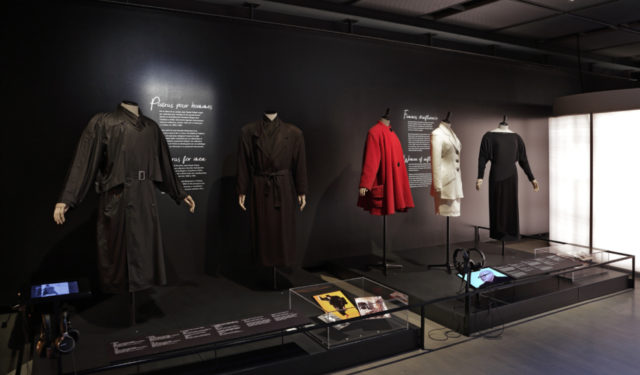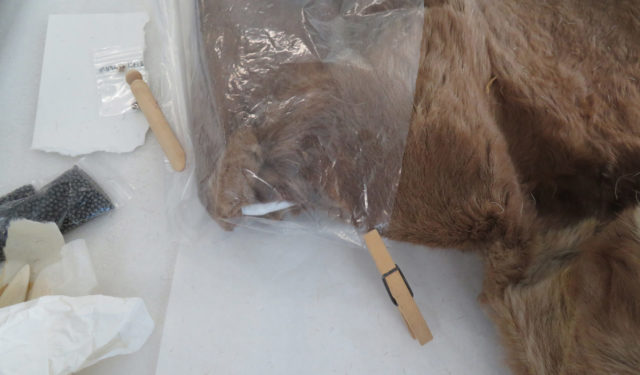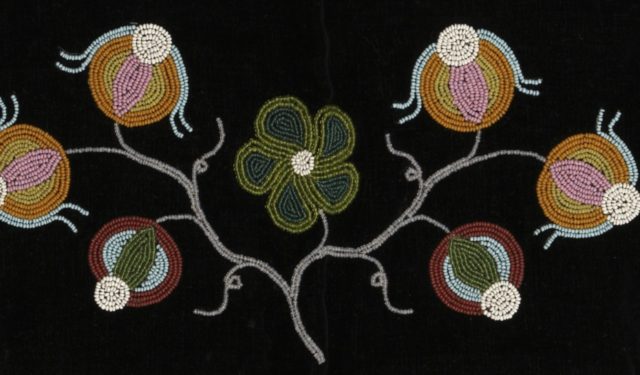In Fine Feather: The Conservation of a Balenciaga Dress
An evening gown decorated with hundreds of feathers was the subject of a meticulous conservation treatment.
June 13, 2018
This remarkable garment was designed by Cristóbal Balenciaga, who established his couture house in Paris in 1937. Active until 1968, Balenciaga quickly became recognized as the “master” of couture and a major figure in 20th century fashion. His clothes were celebrated for their impeccable craftsmanship and innovative silhouettes.
This particular garment was first shown in Balenciaga’s 1966 fall/winter collection. Jeanine C. Beaubien, a prominent member of the Quebec theatre community and lover of avant-garde fashion, donated the dress to the McCord Museum in 2012. She bought the outfit from luxury department store Holt Renfrew after the head of the store, Alvin J. Walker, brought it back from Europe.
The garment consists of two parts: a sheer dress covered with feathers, and a peach silk crepe jumpsuit to wear underneath instead of a slip. The dress is made from a sheer, stiff, peach-coloured organza, which fibre analysis has revealed to be not of the expected silk, but polyester.
It is covered with long, thin ostrich feathers, dyed peach with cut black tips. Each feather has been individually glued to the fabric with clear adhesive at its base, leaving the lightweight, flexible shafts free to move and sway as the costume is worn. The fabric was produced by the French textile workshop Maison Lemarié, which supplies richly embellished fabrics to couture houses like Balenciaga and Chanel.
The cut of the garment was kept simple, likely to emphasize the striking, three-dimensional fabric. The long, sleeveless, A-line dress has princess seams at the front and back, with the front seams set towards the sides of the garment so as to avoid side seams. The neckline and armhole edges are rolled and hand-sewn for a narrow, clean finish. All seam allowances have been finished with hand stitching. The dress closes with snaps along the centre back.
CONSERVATION TREATMENT
Before going on display in the Balenciaga, Master of Couture exhibition, the costume was brought to the conservation lab for examination. The dress and jumpsuit were both in good condition, but still needed conservation treatment before they could be exhibited.
Besides minor sewing repairs, the main concern of the conservation treatment was to address the feathers on the dress. Many of the feathers were broken or missing, leaving noticeably bare areas along the hem, neckline, and armholes. The missing feathers had broken off, snapping along the bases of their thin, fragile shafts, rather than falling off because the adhesive had failed. We had a bag of about 260 loose feathers that had fallen off the dress and been saved.
Aesthetics were a major consideration in this treatment, as the goal was to restore the dress’s original, intended appearance as an example of avant-garde fashion. Since these original feathers were available, we decided to reattach them to the dress. First, we tried stitching the feathers back onto the dress with fine hair silk thread, but this was unsatisfactory because they were prone to slipping through the stitches.
Instead, the feathers were adhered to the dress fabric. We used Lascaux 498 HV adhesive, a glue favoured in conservation for its long-term chemical stability. There were not enough loose feathers to fill in all the bare areas, so those available were strategically placed to fill in major losses and even out the overall appearance of the dress. Since adhesive residue from missing feathers remained on the fabric, the reattached feathers could be glued over this residue to ensure they were put in the right places.
While adhesive repairs are less reversible than stitched repairs, adhesive use did have advantages in this case: it secured the feathers better than stitching, it was less time consuming, and it replicated how the feathers were originally attached.
Even after conservation treatment, the dress remains fragile. The long, thin, delicate feathers are vulnerable to physical damage, so careful handling of the costume is of utmost importance. During the exhibition, the dress will be displayed in a closed vitrine for protection. When not on display, the dress is stored flat in a closed box with acid-free tissue paper to protect it from light and physical forces.






